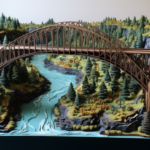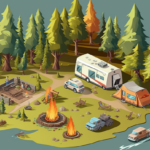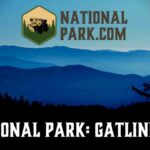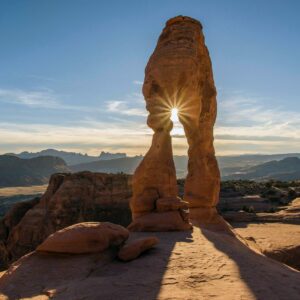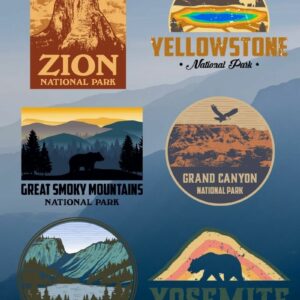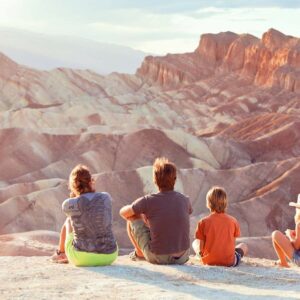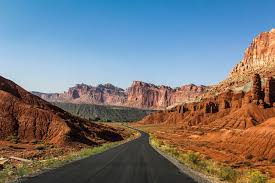Yellowstone National Park
Situated on the Yellowstone Caldera, Yellowstone National Park has an expansive network of geothermal areas including boiling mud pots, vividly colored hot springs such as Grand Prismatic Spring, and regularly erupting geysers, the best-known being Old Faithful. The yellow-hued Grand Canyon of the Yellowstone River contains several high waterfalls, and four mountain ranges traverse the park. More than 60 mammal species including gray wolves, grizzly bears, black bears, lynxes, bison, and elk, make this park one of the best wildlife viewing spots in the country.
Park History
As the first national park ever created, Yellowstone is full of rich and diverse history.
Yellowstone National Park set the stage for the creation of other national parks, and had many important milestones. From its original creation to its recovery from vandalism, aided by the U.S. cavalry, there is so much to learn about Yellowstone! Here are six of the most important moments in the history of the first national park.
The Yellowstone Act
Early in 1872, Congress moved to set aside 1,221,773 acres of public land straddling the future states of Wyoming, Montana, and Idaho as America’s first national park. President Grant signed the bill into law on this day in 1872. The Yellowstone Act of 1872 designated the region as a public “pleasuring-ground,” which would be preserved “from injury or spoliation, of all timber, mineral deposits, natural curiosities, or wonders within.” This law made history, as the first law to set aside land for preservation.
Ferdinand Hayden
A key chapter in Yellowstone’s development came in the summer of 1871, when geologist Ferdinand Hayden led the first federally funded expedition to the region. Along with botanists and zoologists, Hayden’s team also included a photographer and a young artist named Thomas Moran. Moran produced more than 30 sketches and watercolors of Yellowstone’s cliffs, geysers and rivers. Combined with the photographs, Moran’s artworks offered Americans their first glimpse of the area’s natural beauty. When the paintings were later exhibited in Congress, they helped win many politicians over to the idea of making Yellowstone a “national playground.” On February 27, 1872, the House of Representatives voted 115 to 65 in favor of setting the region aside as America’s first national park. President Ulysses S. Grant signed the bill into law just two days later.
The Early Years
During its early years, Yellowstone suffered due to meager government funding and a series of ineffective superintendents. Tourists vandalized the park’s geysers and rock formations, and poachers and private interests hunted its wild game and harvested its timber. The damage only slowed in 1886, when a U.S. Army cavalry company was dispatched to administer Yellowstone and stand guard over its natural treasures. The troops immediately went to work expelling squatters, rounding up poachers and enforcing regulations. By 1894 their successes encouraged Congress to pass a new law protecting the park’s wildlife. Army forces remained in the wardens of Yellowstone until 1918, when they handed the reins to the newly created National Parks Service.
The Railroad Comes to Yellowstone
Railroad arrived in 1883, allowing easier visitor access. Before the introduction of railroads, Yellowstone received only 1,000 visitors a year, due to its remote location. The first passenger train arrived on June 11, 1908. The arrival of passenger trains nearly doubled the amount of visitors the park received each year after its installment.
Automobiles
Automobiles allowed into the park in 1915, making visits easier and more economical. Nowadays, automobile access makes the wonders of the park more accessible than ever, with some roads leading directly to vantage viewpoints.
Horace M. Albright
Horace M. Albright was the second director of the National Parks Service. Before becoming director, he served as second in command to Stephen Mathers, and was acting director while Mathers was ill. As the agency’s director, he greatly increased the number of parks east of the Mississippi and helped preserve historic sites.

How The Park Was Formed
The formation of Yellowstone is a past and present example of the earth’s geological processes.
Yellowstone is one of the most geologically active places on earth, with the hydrothermal system that creates the geysers and a shallow source of magma, which causes earthquakes. Yellowstone is also an incredible example of volcanism.
Earthquakes
Yellowstone is one of the most seismically active areas on earth, with 1,000 to 3,000 earthquakes annually. Earthquakes are caused by movement of the earth’s crust along fractures, often aided by volcanic activity. The movement releases energy as shock waves, creating the phenomena we know as earthquakes. Yellowstone’s earthquakes make the hydrothermal system that the park boasts possible by keeping the fractures they occur along open. Yellowstone’s earthquakes happen in “swarms”, where multiple earthquakes will occur within a small time frame, close to one another. These earthquakes serve an important scientific purpose- they help scientists map the subsurface geology of the park. The seismic activity of the park is monitored by seismometers, which help track and predict seismic activity. This allows the park to keep visitors safe in case of earthquakes.
Geysers
Yellowstone was originally set aside as a national park in order to protect the unique hydrothermal features of the area. These features include the many geysers that brought the park its fame. The hydrothermal phenomena are the subject of research by many different fields, including medical and forensic fields. Without the Yellowstone volcano, these features would not exist. They are the visible expression of the magma pool that lies close to the surface. The pressure and heat of the magma pool, when added to the groundwater that exists in the area, superheats the water, and creates the famous geysers. The hot water dissolves silica in the rock, which then deposits to create the unique appearance of the hydrothermal basins that surround the geysers.
Supervolcano
Yellowstone is home to a supervolcano, and is an example of hot spot volcanism. A body of magma is close to the surface in the Yellowstone area, and creates magma plumes, which transport heat from the earth’s mantle to its crust. When tectonic plates pass over these “hot spots”, it creates volcanic activity. The magma reservoirs underneath Yellowstone’s crust create stress, and contribute to the area’s volcanic activity. 2.1 million years ago, one of the largest volcanic eruptions that we know of occurred in the Yellowstone area, ejecting 6,000 times the mass of the Mt. St. Helens eruption.
640,000 years ago, another eruption occurred, creating the area known as the Yellowstone Caldera. Magma is so close to the surface of the Caldera that on occasion, the floor lifts due to heat and pressure, sometimes up to three feet. This uplift is often accompanied by earthquakes, and some believe that the earthquakes act as a release of pressure, preventing another eruption.
Geothermal Features
Four types of thermal features can be found in Yellowstone. The four types of thermal features are geysers, hot springs, mud pots, and fumaroles. Geysers are superheated water, usually heated by magma deposits, which are subjected to extreme pressure, causing them to shoot water and steam into the air. Yellowstone is home to over half of the active geysers in the world. Hot springs are springs that are created by heated water rising from the earth’s crust. Hot springs are huge attractions around the world, but some can get so hot that immersion can result in burns.
Mud pots are acidic hot springs, which look like bubbling mud. This is caused by the presence of hydrogen sulfide, which breaks down clay from rocks. A fumarole is an opening in the ground near a volcano, which allows gases to emerge. These gases can color surrounding rocks, and are caused by magma flow underneath the surface. This variety of thermal features allowed Yellowstone to qualify for preservation, and are well worth a visit!
Waterfalls
About 290 waterfalls can be found throughout Yellowstone’s 2.2 million acres. Many rivers flow through the bounds of the park, and many create waterfalls as they go. There are waterfalls located along the Yellowstone River, the Madison River, Bechler River, and Snake River. These waterfalls are often caused by river drainage.

Wildlife
Yellowstone National Park supports more than 400 species of vertebrates including fish, amphibians, reptiles, birds, and mammals.
Yellowstone is home to the largest concentration of mammals in the lower 48 states. There are 67 species of mammals, 285 species of birds, 16 species of fish, 6 species of reptiles, 5 species of amphibians, and more than 7 aquatic nuisance species located in Yellowstone National Park. Two threatened species call the park home; the Canada lynx and grizzly bears. Wolverines are a proposed threatened species. Here are six of the most distinct species in Yellowstone.
Bison
Yellowstone has the largest, free-roaming herd of bison in the world. This park is the only place where bison have lived continuously in the United States. These bison roam free over the park, and are one of the few herds which have not been interbred with cattle for preservation purposes. They exhibit wild behavior, including mating rituals and migration patterns, that are consistent with their ancestors. Bison were on the verge of extinction as recently as a century ago. They were hunted extensively, and poachers reduced the Yellowstone herd to as little as two dozen. The bison were protected by the U.S. army, and the population slowly recovered, to the number it is today. They are the largest land dwelling mammal in the United States, at an intimidating 2,000 pounds. They have short hair, and powerful muscles, as well as a hump on their necks.
Bison are herd animals, and the herds are often directed by older female bison. The size of herds varies throughout the year, with smaller groups in the winter and larger groups in the summer. Their diet consists mainly of grasses. Bison are so large that they have few predators. The only large predators that hunt bison are wolves and grizzly bears. They may seem large and slow, but bison move quickly, and their size can make them dangerous. The bison herd in Yellowstone has expanded so significantly that park officials are in the difficult position of having to manage a large population of an animal that was once nearly extinct! Bison are an awe inspiring sight to all visitors of the park.
Gray Wolves
After two decades of extinction, gray wolves were restored to Yellowstone National Park in 1995. Wolves were flown into the area from places like Canada and Montana, in an attempt to reintroduce the species. The restoration of the wolf population in Yellowstone allows a protected area for the species, and allows for research on the population that could not be done elsewhere. In particular, the impact of the wolves on the Yellowstone ecosystem has been a topic of research. Wolves are social animals, and live in packs. The average pack size in Yellowstone is 10 individuals, but this is not indicative of pack size in other areas, as size is dependent on conditions and abundance of prey. The pack dynamic plays into all aspects of the wolves’ lives, from the raising of young to hunting.
Their hunting style allows them to prey on larger animals, including bison, that predators of their size would not otherwise be able to. A wolf kill benefits not only themselves, but other animals, particularly scavengers, in the area. Wolves are highly territorial. The main cause of wolf death within the park is territory disputes with other packs. Outside of the park, the main cause of death is human based. Research is still being done on the wolves of Yellowstone to this day. Researchers capture a small population of wolves, and put tracking collars on them. They now collect data on the wolves and their behavior. There has never been a wolf attack on a human in Yellowstone, and wolves will not confront humans. Do not feed them, and treat them with respect.
Grizzly Bears
Yellowstone is home to grizzly bears, which have a limited range across the United States. The park is home to both grizzly and black bears. Grizzly bears are larger and more aggressive than black bears. Grizzly bears are found only in Yellowstone and Montana in large numbers in the U.S., and were listed as a threatened species in 1975. There are approximately 150 grizzly bears located in Yellowstone. In the Greater Yellowstone Ecosystem, there are estimated to be 757 grizzly bears. The more aggressive nature of the grizzly bear presents a challenge to human neighbors of the park, and safety is an ongoing discussion. Grizzly bears have a wide range of coloring, from blonde to black. Most in the Yellowstone area boast a brown coloring. They are solitary, with adult males dominating the social hierarchy, followed by adult females with cubs.
They are omnivores, meaning they eat both plants and meat. Grizzly bears are known to both forage and hunt. They primarily eat elk and bison, usually feeding on already killed individuals, although they are known to hunt elk calves. They will eat human food and garbage, so keeping your food and waste stored is important for park safety. Grizzly bears hibernate in dens during the winter, due to food shortages. They live off of a layer of fat that they develop before the winter. Grizzly bears are able to wake up in response to danger during hibernation. They usually emerge from hibernation around late February. Grizzly bears benefit immensely from the presence of grey wolves in the park. They often feed off of already killed elk and bison, left from wolf hunts.
Birds
285 species of birds can be found in Yellowstone, with 150 nesting. The wide array of habitats found in the park allow for diversity in the bird species found in the area. Bird species in the park are monitored by the Yellowstone National Park bird program, which collects information on the different species and tracks species of concern.
The species of concern currently located in the park are the trumpeter swan, the golden eagle, and the common loon. A species of concern is not a threatened species, but a species where there is concern for their habitat or survival, but insufficient data to prove this concern. The programs main species of interest are raptors, wetland birds, and songbirds/woodpeckers. The monitoring of birds can be used as an environmental health predictor, as their migration patterns change with food availability. Some of the species the park monitors include owls, osprey, ravens, and Sandhill cranes.
Yellowstone River Otter
The Yellowstone River Otter is one of the most adorable inhabitants of the park, but also one of the most difficult to spot! During the day, they are usually found in their dens. They are easiest to spot in the winter, when their dark coats stand out against the snow. River otters have been spotted around most of Yellowstone’s major lakes and rivers. Their webbed feet and strong tails make them strong swimmers, and they are able to submerge themselves underwater for up to three minutes. They feed on fish, frogs, and crayfish. They have no natural predators in the water, but on land they can be hunted by wolves and foxes, and are in danger of having their food stolen by birds of prey.
Elk
Yellowstone is a migratory destination for a large number of elk! In the summer, anywhere from 10,000 to 20,000 elk make their home within the bounds of the park. In the winter, that number dwindles to less than 4,000. They are often found in the Cascade Meadows and the Madison Canyon during the summer months, and tend to congregate near the hot springs in the fall. Elk can weigh up to 700 pounds and stand five feet tall at their shoulder.
Their impressive antlers make for a majestic sight, and they are the most photographed animal in the park. Antlers are mostly found on male elk, although some female elk have been known to grow them as well. These antlers are used to settle disputes, where males will lock antlers and wrestle with them. When fully grown, their antlers can weigh 30 pounds apiece! They are drawn to the high elevation grassland in Yellowstone during the summer, which is the cause of their annual migration. For decades, debate surrounded the elk population in the park. The concern was whether the animals were overgrazing the area, negatively impacting plant diversity. With the reintroduction of the wolves, one of the elk’s main predators, the discussion shifted to the dwindling population. Now, it appears that the two species are coexisting.

Plant Life
Yellowstone’s diverse range of climates and conditions allow it to become a home to many different types of plants.
Lodgepole Pine
The most common tree in Yellowstone is the lodgepole pine. This adaptable evergreen conifer dominates 80% of the forested area in the park. It thrives near the ocean and in dry montane climates. There are four different subspecies of lodgepole pine, which are the Bolander pine, the shore pine, the Sierra lodgepole pine, and the lodgepole pine. Depending on subspecies, this plant can grow as a tree or as a shrub. Shrubs can be anywhere from 3 to 10 feet tall, while the evergreens reach a height of 160 feet. The species name is contorta, due to the twisted appearance of the shrub subspecies and the twisted needles of the tree subspecies. The lodgepole pine is a fire dependent species, meaning that it requires regular wildfires to thrive.
Mountain Big Sagebrush
Yellowstone is home to a variety of sagebrush called the Mountain Big Sagebrush. This plant has light grey branches and foliage, with yellow flowers. They range in size from 0.5 to 3 meters tall. Tall sagebrush is indicative of arable land. Sagebrush is a very long lived plant under the right condition, sometimes living to 100 years old. The plant thrives in arid and semi-arid conditions, and provides food and habitat for many species of animal. There are several major threats to the sagebrush ecosystem, including conversion to agricultural land, livestock grazing, and invasive species. This plant has also been used for medicinal purposes by Native American tribes, including the Navajo and Zuni people.
Wetlands
Approximately 38% of the park’s plant species—including half of the rare plants—are associated with wetlands and 11% grow only in wetlands. Wetlands provide essential habitat for Yellowstone’s rare plants, thermal species, reptiles and amphibians, and for numerous insects, birds and fish.
Hydrothermal Plant Communities
Fascinating and unique plant communities have developed in the expanses of thermally heated ground. Many of the species that occur in the geyser basins are actually species that tolerate tremendously different conditions, and thus grow all over the western United States. Other species, though, are typical of the central Rockies, or are regional endemics. Hydrothermal plant communities demonstrate in very short periods of time that change is fundamental in any natural system. In a few days, the ground can heat up, perhaps triggered by an earthquake, and kill plants, while an adjacent area may cool, allowing plants to invade a previously inhospitable place.
Wildflowers
Yellowstone is home to many beautiful wildflowers. Elevation, relative temperatures, soil types, and precipitation patterns all play a role in what you find blooming in various areas at different times of the year. In addition, far-reaching events such as fires can cause spectacular blooms of species that thrive on the conditions these events create. Remember that many of Yellowstone’s wildflowers are also very important parts of animal diets. The bulbs of spring beauty and glacier lily, for example, are vital spring foods of the grizzly bear. Wild strawberries are collected by ground squirrels and chipmunks; the seeds of most wildflowers are used by birds and insects. Even the petals of many flowers are eaten by animals. Bees and other insects collect nectar and pollen.
Yellowstone Sand Verbena
Yellowstone is home to a number of rare plants, including the Yellowstone Sand Verbena. This flowering plant is reproductively isolated from its closest relative, and grows along the shore of Yellowstone Lake. The discovery of this plant was unexpected. The high elevation of Yellowstone Lake was considered incompatible with other members of the species, which usually occur along a coastal region. The plant occupies only 1.48 acres, although it is believed to have once been more widely spread along the shore of the lake. Botanists believe that the heat from the thermal features of Yellowstone may help this plant survive. The Verbena grows low to the ground, and has small white flowers.

Best Things To Do
Spanning three states, thousands of acres, and different climates, Yellowstone offers a wide variety of activities.
From activities for a seasoned outdoorsman to a lover of nature and beautiful views, Yellowstone has something for everyone. Here are 7 of our favorite things to do at Yellowstone.
Visit the famous Old Faithful!
Old Faithful is one of the most famous geysers in the park, and is one of the thermal features that originally qualified the park for protective status. Yellowstone’s preservation of the geological processes that allow thermal features like Old Faithful to occur a world-famous geyser, erupts every 92 minutes on average. Old Faithful is one of the six geysers that park officials are able to predict with regularity, making it one of the easiest to schedule! You can view this incredible sight at the Old Faithful viewing area, or along one of the boardwalks that surrounds the basin that the geyser is located in. Old Faithful is a must-see for any visitors to Yellowstone.
Travel back in time at the Grand Canyon of the Yellowstone!
This spectacular sight shows the formation of Yellowstone itself. The Grand Canyon of the Yellowstone was created approximately 640,000 years ago, when a huge volcanic eruption shook the area. The chamber of magma that was expelled in this eruption caved in, creating the first step in the Grand Canyon of the Yellowstone. Over the years, the Yellowstone River eroded the rocks of the canyon walls, and continued to erode them today, making the canyon deeper and wider. The Lower Falls goes over a layer of volcanic rock that is more resistant to erosion.
The rocks of the canyon walls were thermodynamically altered by the features of the park, creating spectacular colors and patterns. Osprey are a common sight around the canyon, and build their nests in the area. If you are lucky, you may be able to see one! You can see the beautiful sights and views of the canyon in two different ways. Yellowstone offers hikes that take you through the canyon. There are also driving paths that take you to strategic vantage points. The Grand Canyon of Yellowstone is an awe-inspiring sight that you can’t afford to miss.
See the largest hot spring in the United States!
The Grand Prismatic Hot Spring is one of the first thermal features to be discovered in Yellowstone, and claims the third largest area of any hot spring in the world. It is 370 feet wide and 160 feet deep. It was first described as a “boiling lake” in early accounts. The Grand Prismatic has striking coloration, which draws visitors from all around the country. Microbial mats and mineral rich waters produce beautifully vivid colors surrounding the spring, which vary based on time of year and other conditions. The colors can range from green to bright red, depending on the amount of chlorophyll in the microbial mats. The water is a stunningly clear blue. The Grand Prismatic Hot Spring is a unique and beautiful sight!
Visit the historic Lamar Valley!
Located in the northeast corner of Yellowstone, Lamar Valley is known as the Serengeti of America. It was formed during the last Ice Age, and was created through glacier erosion. It is one of the best places in the park to see wolves and grizzlies (with proper precautions, of course!). The road through this valley is the only one in the park open year round. Lamar Valley is also home to the Lamar Buffalo Ranch, sometimes called the birthplace of modern day conservation. During the 1900s, bison nearly went extinct.
In an effort to preserve the species, Congress purchased 21 buffalo and raised them on the Lamar Buffalo Ranch. This location was essential in the preservation of the bison, and the herd grew large enough to be released to breed with the free roaming bison in the rest of the park. Today, the Lamar Buffalo Ranch is home to multiple education programs, hosting students in wildlife studies, and has been named as a historical monument. The ranch has partnerships with Expedition Yellowstone and Yellowstone Forever Institute, and these partnerships allow the National Park Service to use the ranch as a model for environmental stewardship. The Lamar Valley provides visitors with unique wildlife viewing opportunities, as well as a chance to learn about the history of conservation.
Travel to Yellowstone Lake!
This is the highest elevation lake in North America, at 2,357 meters above sea level. It is 20 miles long and 14 miles wide. The lake freezes completely every winter, and the water remains shockingly cold year round. Yellowstone lake also houses the largest population of cutthroat trout in North America. This is notable because the cutthroat trout is usually found in the Pacific Ocean, and Yellowstone Lake drains into the Atlantic. Scientists posit that the lake once drained to the Atlantic through a series of rivers, but has since changed its drainage point.
This lake is geologically unique. If the water were drained, conditions would be similar to the rest of Yellowstone Park, with geysers, hot springs, and canyons. There are also two volcanic vents underneath the lake! While it is not recommended that you swim in Yellowstone Lake, due to the cold temperatures, the locale attracts visitors for both fishing and boating. There are several hiking trails and campsites surrounding the area as well.
Visit a Supervolcano!
The Yellowstone Caldera is located in the northeast area of the park, and was formed by three supereruptions over the past two million years. The caldera lies above the Yellowstone Hotspot, where magma is found close to the surface. Geologists monitor this area closely for volcanic activity. As a supervolcano, the Yellowstone Caldera erupts more violently than other volcanoes, making it especially important to keep track of any activity in the area. Geologists predict that the volcano will erupt again, but likely not for thousands, even millions, of years. The Yellowstone Caldera is an incredible sight, and an incredible opportunity to learn more about one of the most powerful natural phenomena.
Wander around Mammoth Hot Springs!
Mammoth Hot Springs is a large, complex formation of hot springs in Yellowstone Park. Heated by the same magma as the Yellowstone Caldera, Mammoth Hot Springs is an example of the hydrothermal forces at work in the park. Underlying limestone in the area allows for the formation of the travertine terraces, which are complex rock formations that the water from the hot springs runs over. It resembles a cave turned inside out, and thermophiles, or heat loving organisms, create colorful stripes along the rock. These features are beautiful, but very fragile, and preservation is the most important consideration in this area.







